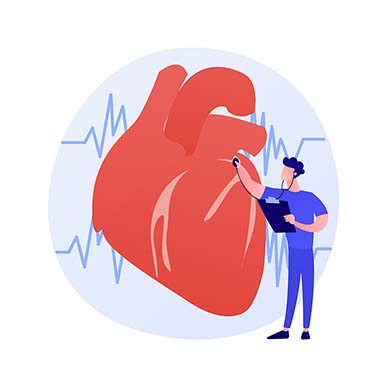Introduction: Addressing Men’s Heart Health Concerns
Heart health remains a pivotal concern, especially for men over 50, given the increased prevalence of cardiovascular issues. This article aims to delve into the critical aspects of LDL cholesterol, triglycerides, and the significance of regular screenings in maintaining optimal heart health.

Cardiology clinic, hospital department. Healthy heart, cardiovascular prevention, healthcare industry idea design element. Electrocardiogram, EKG. Vector isolated concept metaphor illustration
Table of Contents
Understanding LDL Cholesterol and Its Impact
Low-Density Lipoprotein (LDL) Cholesterol: LDL cholesterol, often termed ‘bad cholesterol,’ plays a significant role in plaque buildup within arteries. This buildup can lead to atherosclerosis, narrowing blood vessels and escalating the risk of heart disease and stroke. Men aged 50 and above are particularly susceptible to elevated LDL levels.
Triglycerides: Unraveling Their Role in Heart Health
Triglycerides: These fats circulate in the bloodstream and store excess energy from the diet. Elevated triglyceride levels often accompany high LDL cholesterol, contributing to cardiovascular complications. Men over 50 must monitor triglyceride levels as they intertwine with overall heart health.
Importance of Regular Screening for Men Over 50
Regular health screenings, encompassing lipid profiles and cholesterol tests, are instrumental in identifying potential risks early. Timely detection empowers individuals to adopt proactive measures, including dietary adjustments, exercise routines, and medication if necessary, to mitigate cardiovascular risks.
Lifestyle Modifications for Enhanced Heart Health
Dietary Recommendations

- Balanced Diet: Encourage a diet rich in fruits, vegetables, whole grains, lean proteins, and healthy fats, while minimizing processed foods and saturated fats.
- Omega-3 Fatty Acids: Incorporating sources like salmon, flaxseeds, and walnuts can help lower triglyceride levels.
Physical Activity

- Regular Exercise: Engaging in aerobic activities for at least 150 minutes per week aids in managing cholesterol levels and overall heart health.
- Strength Training: Combined with aerobic exercise, strength training promotes better cardiovascular fitness.
Key Takeaways: Prioritizing Heart Health
As men reach 50 and beyond, prioritizing heart health becomes imperative. Understanding the significance of LDL cholesterol, triglycerides, and embracing routine screenings empowers individuals to make informed lifestyle choices, significantly reducing the risk of heart-related complications.
Conclusion: Promoting Heart Health Awareness
In conclusion, fostering awareness among men over 50 regarding the correlation between LDL cholesterol, triglycerides, and heart health is pivotal. By implementing lifestyle modifications and prioritizing regular screenings, individuals can take proactive steps toward a healthier heart, thus positively impacting their overall well-being.
This comprehensive approach, coupled with a commitment to a heart-healthy lifestyle, stands as the cornerstone for mitigating heart disease risks in men over 50.
The quest for optimal heart health is a journey that demands diligence, awareness, and informed choices.
By focusing on these elements, individuals can foster a robust foundation for a heart-healthy life beyond 50.
Extra Tip
What is angioplasty?
Angioplasty is a medical procedure used to widen narrowed or obstructed blood vessels, typically arteries, to restore proper blood flow. It’s commonly employed to treat conditions such as coronary artery disease (blockages in the heart’s blood vessels), peripheral artery disease (blockages in other arteries, often in the legs), and sometimes in other areas of the body.
During angioplasty, a thin, flexible tube called a catheter is threaded through an artery, usually starting from the groin or wrist, and guided to the affected area using imaging techniques such as X-ray or fluoroscopy. At the narrowed or blocked site, a small balloon at the tip of the catheter is inflated, pushing aside the plaque buildup or blockage against the arterial walls, thus widening the vessel and restoring blood flow.
Sometimes, a stent (a small mesh tube) is also inserted at the site of the blockage during the angioplasty procedure. The stent acts as a scaffold to keep the artery open after the balloon has been inflated and removed. Drug-eluting stents, which release medication to help prevent the artery from becoming blocked again, are often used in modern angioplasty procedures.
Angioplasty is a minimally invasive procedure compared to traditional surgery and is usually performed in a specialized cardiac catheterization laboratory (cath lab). It can help alleviate symptoms associated with reduced blood flow and reduce the risk of heart attacks, strokes, and other complications related to impaired blood circulation.



